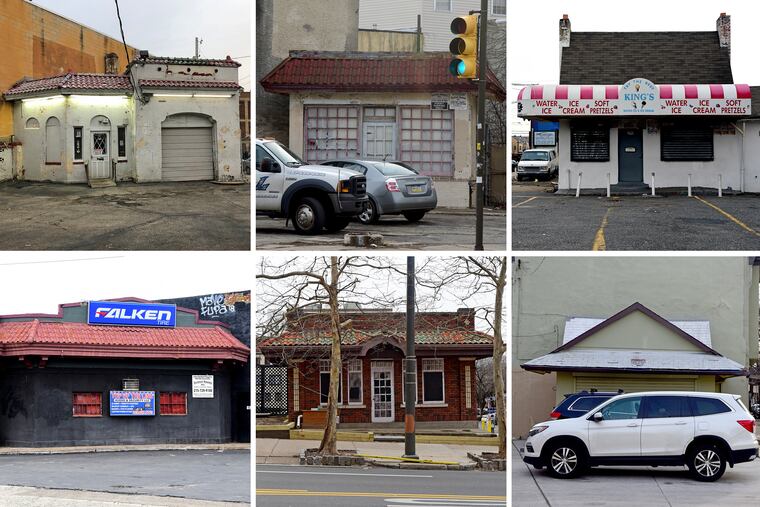The forgotten history of Philadelphia’s early gas stations | Inga Saffron
Gassing up used to mean a trip to a diminutive Spanish Colonial hacienda or an English Cottage.

The gas station as we know it was not invented until the 1920s, more than a decade after the automobile came into popular use. Because it was a completely new building type — developed to accommodate a new technology, the gas pump — there were no design precedents for oil companies and their architects to follow. The form had to be invented from scratch.
You can still see plenty of examples of their experiments around Philadelphia, miraculous survivors from a time when filling stations were treated as real architecture. Spanish Colonial stations dominate in the city, as they do around the country, but a fine example of the English cottage style can be found at 33rd and Cecil B. Moore in Strawberry Mansion. Ironically, almost all these early filling stations were in residential areas. Just imagine if someone tried to build a gas station in the middle of a neighborhood today!
Oil companies were able to slip these diminutive buildings onto residential blocks because zoning laws were still in their infancy, and Americans were rushing to acquire cars. Before filling stations came into existence, car owners had to buy their gasoline in bulk and store it at home in barrels or metal drums. When they wanted to go for a ride, they dispensed the viscous substance from the barrel like beer from a keg, transferring it into a canister, and then pouring it through a spout into the car’s gas tank.
With the invention of the gas pump in 1905, this messy process came to an end. Soon grocers around the city were installing gas pumps on the sidewalks in front of their stores. But city officials became concerned about safety and outlawed curbside pumps (just as Philadelphia did recently with curbside electric chargers). Oil companies responded by constructing their own purpose-built filling stations, typically on corner sites where they could attract customers from two directions.
To get around public resistance, oil companies used architecture to make their outlets more palatable to neighborhood residents. One of the earliest gas stations in Philadelphia appears to have been inspired by the Tempietto del Bramante in Rome. Designed by Pittsburgh architect Joseph F. Kuntz for the Atlantic Refining Co., it dominated the corner of 40th and Walnut. Its classical motifs would have mollified proponents of the City Beautiful movement, who were determined to root out ugly industrial buildings from America’s downtowns. Kuntz would go on to design 16 classical filling stations in Philadelphia. Sadly, all are gone.
Because there were dozens of gasoline manufacturers in those days, and there was virtually no difference among brands, these elaborate filling stations also served to differentiate their products. The same year that Atlantic built its Tempietto, the Gulf Refining Co. came up with a very different prototype: a miniaturized Spanish Colonial hacienda. Tricked out with terra-cotta roof tiles and arched windows, the prototype was just big enough to house an office and restrooms. Two other suppliers, Texaco and Ventura Refining Co., soon copied the design, further refining the details.
You can find several intact Spanish Colonial filling stations in Philadelphia. The best preserved, and most elaborate, is the tiny brick structure on North 20th Street, just south of Cherry, that is maintained by the Pennsylvania Horticultural Society. Over the last century, the terra-cotta tiles on its broad hip roof have developed a lovely two-tone patina. An onion-shaped cutout in the roof marks the main entrance.
The Spanish Colonial station at Sedgley and Kensington Avenues, across from the Market-Frankford El, stands out for a different reason: It includes a garage bay. Until the late ‘30s, most filling stations were strictly places to gas up.
As oil companies added repairs to their businesses, the original filling station buildings became obsolete. Most were too small to accommodate garage bays for mechanics. Many early gas stations were converted to other businesses, such as used-car lots. In Philadelphia, those early filling stations proved to be perfect for water-ice stands. Both the English Cottage station in Strawberry Mansion, and the one at Fifth and Passyunk in Queen Village dispensed the summer treat after they stopped selling gasoline. Based on its sharply peaked roof, chimney, and white brick, the Strawberry Mansion station was probably built by Pure Oil, which specialized in cottage designs.
Because they are now entering their second century, it is amazing that so many early filling stations still survive in Philadelphia, especially given the voracious demand for potential lots by developers. One explanation for their continued existence may be that the stations sit atop old oil tanks and the sites would require expensive remediation to develop. Even so, the tiny Queen Village station is now up for sale.
What a shame it would be to lose these tokens of an age when a trip in an automobile meant an entertaining excursion into the countryside. Our cars have become faster and more powerful, but gassing up under the blaring neon of a plasticky canopy isn’t half the fun of gliding up to a Lilliputian Spanish hacienda.